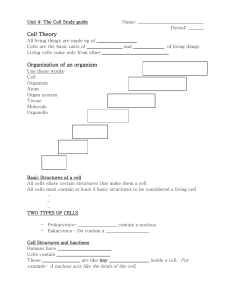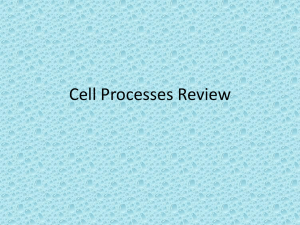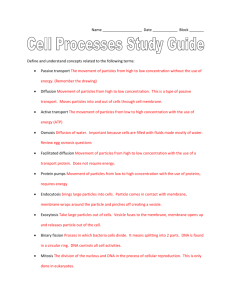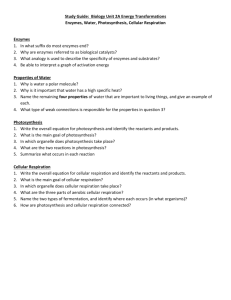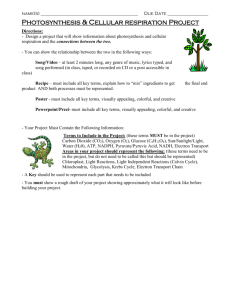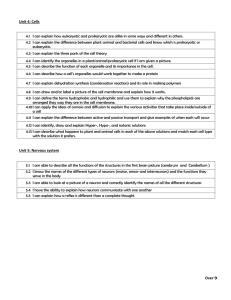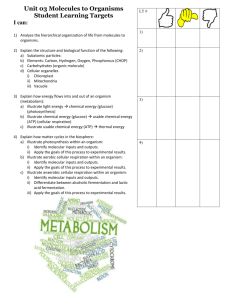Final Exam Review_ Fall 2013 Scientific Method VOCABULARY 1
advertisement
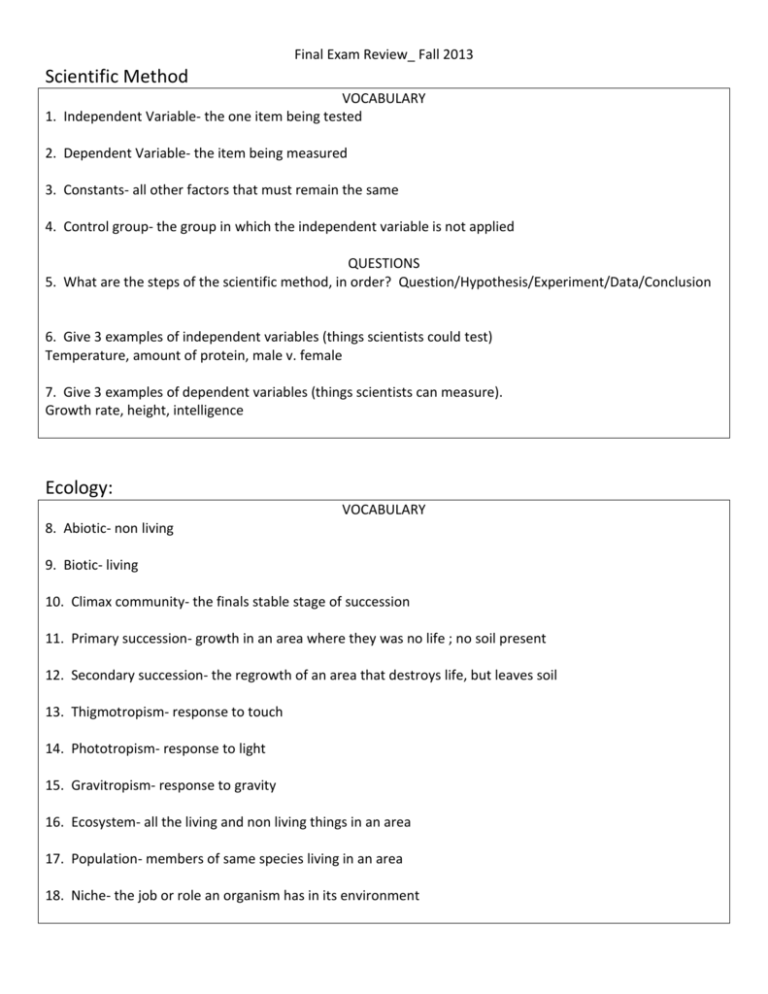
Final Exam Review_ Fall 2013 Scientific Method VOCABULARY 1. Independent Variable- the one item being tested 2. Dependent Variable- the item being measured 3. Constants- all other factors that must remain the same 4. Control group- the group in which the independent variable is not applied QUESTIONS 5. What are the steps of the scientific method, in order? Question/Hypothesis/Experiment/Data/Conclusion 6. Give 3 examples of independent variables (things scientists could test) Temperature, amount of protein, male v. female 7. Give 3 examples of dependent variables (things scientists can measure). Growth rate, height, intelligence Ecology: VOCABULARY 8. Abiotic- non living 9. Biotic- living 10. Climax community- the finals stable stage of succession 11. Primary succession- growth in an area where they was no life ; no soil present 12. Secondary succession- the regrowth of an area that destroys life, but leaves soil 13. Thigmotropism- response to touch 14. Phototropism- response to light 15. Gravitropism- response to gravity 16. Ecosystem- all the living and non living things in an area 17. Population- members of same species living in an area 18. Niche- the job or role an organism has in its environment 19. Biomagnification- the magnification of a substance as you move up the trophic levels of a food chain 20. Trophic Level- a feeding step in a food chain 21. Commensalism- one organism benefits, the other is not helped or harmed 22. Parasitism- one organism benefits, one organisms is harmed 23. Mutualism- both organisms benefit 24. Predator- the organism doing the hunting and eating 25. Prey- the organism being hunted 26. Decomposer- breaks down the dead, cycling nutrients 27. Interspecific Competition- fighting for resources among members of different species 28. Intraspecific Competition- fighting for resources among members of the same species QUESTIONS 29. What are three examples of abiotic factors? Rock, temperature, soil, wind 30. What are three examples of biotic factors? Plants, animals, bacteria 31. After what three major events does secondary succession happen? Forest fire, tornado, flood 32. What must be NOT be present initially order for primary succession to take place? SOIL 33. What does the climax community of the tundra look like? Moss and lichens 34. What does the climax community of the deciduous forest look like? Hardwood trees 35. What does the climax community of the tropical rain forest look like? Vines, layered canopy, trees, lots of animals 36. Why are lichens so important for succession? They break down rock to make soil 37. From where do producers obtain their energy? Sunlight 38. In a food web, which organisms have the highest biomass? Which have the most energy? 1st trophic level (producers) 39. Which organisms bring carbon from the atmosphere into the food chain? Autotrophs/Producers 40. How can humans help decrease the amount of carbon dioxide in the atmosphere? Plant more trees/ reduce burning of fossil fuels 41. How do energy and nutrients differ in moving through an ecosystem? Energy moves in one direction; nutrients cycle Biochemistry VOCABULARY 42. Monomer- a single molecule ; a subunit of a larger molecule 43. Polymer- made up on monomers; a macromolecule 44. Protein- made up of amino acids; functions in growth and repair 45. Carbohydrate- made up of simple sugars; functions in quick energy 46. Lipid- made up of fatty acids & glycerol; functions in long term energy storage 47. Enzyme- a protein that speeds up a chemical reaction by holding reactant molecules in place 48. Substrate- the substance the enzyme works on (or catalyzes) 49. Active site- the place where the substrate fits in the enzyme 50. Adhesion- the ability of water to attach to another substance 51. Cohesion- the ability of water to attach to other water molecules 52. Surface Tension- the cohesive forces between liquid molecules QUESTIONS 53. Fill in the chart. Monomer Carbohydrate Simple sugars Protein Amino acids Lipid Glycerol & fatty acids Function Energy Growth & repair Insulation; long term energy Example Glucose, plant material Meat, eggs, nuts, fish Liquid- plant fats Solid- animal fats 54. Draw/describe an enzyme substrate complex. Label the enzyme, substrate, active site, products. 55. Enzymes (increase/decrease) circle one the rate of a reaction. How do they do that? They lower the activation energy required to start the reaction Cell Structure VOCABULARY 56. Prokaryote- a cell that does not contain a nucleus or membrane bound organelles 57. Eukaryote- a cell that contains a nucleus and membrane bound organelles QUESTIONS 58. What are the three parts of the cell theory? All living things are made of cells. Cells are the basic structure of life. All cells come from preexisting cells. 59. Fill in the chart. Organelle Function Mitochondria Produces ATP via cellular respiration Ribosome Synthesizes proteins Vacuole Stores food, water, waste Lysosome Digests old, worn out cell structures Endoplasmic reticulum Transports materials through cell, modifies fats Golgi body Modifies, packages, and ships our proteins Chloroplast Produces sugar during photosynthesis Cell wall Structure and support Cell membrane Allows materials to pass into and out of cell Nucleus Directs cell functions/ contains DNA Cell Transport VOCABULARY 60. Diffusion- movement of any substance from high to low concentration 61. Osmosis- movement of water from high to low concentration 62. Facilitated diffusion- movement of molecules across a cell membrane through a protein from high to low concentration 63. Passive transport - high to low ; no energy 64. Active transport - low to high; uses energy 65. Dynamic equilibrium- the amt. of molecules inside and outside the cell are the same, no movement 66. Selectively permeable- allows only SOME materials to pass into and out of the cell 67. Solute- what is being dissolved 68. Carrier protein- a protein embedded in cell membrane that substances can pass through to get into or out of a cell 69. Phospholipid- a phosphate head and 2 fatty acids tails that make up the cell membrane 70. Hypotonic solution- more water/ less solute- water moves into cell 71. Hypertonic solution- less water/ more solute- water moves out of cell 72. Isotonic solution- solute concentration same inside and out- no movement of water QUESTIONS 73. Draw the phospholipid bilayer. Label the phospholipid heads, tails, and proteins. 74. Fill in the chart. Definition Direction of water Example movement Hypertonic solution See above Out of cell Salt water Hypotonic solution See above Into cell Freshwater Isotonic solution See above No movement Blood cells in blood stream 75. What factors affect the rate of diffusion? Increase in temperature, concentration, and pressure 76. What factors limit the size of a cell? 77. Fill in the chart diffusion osmosis facilitated diffusion active transport Movement high --> low high --> low high --> low low --> high Requires protein? NO NO YES YES Requires energy? No No No YES VOCABULARY 78. Mitosis- the division of the nuclear contents to form 2 cells 79. Centromere- the center that holds duplicated chromosomes together 80. Centriole- structures in animal cells that assist with cell division 81. Chromosome- a piece of DNA 82. Sister chromatids- two identical pieces of DNA that are attached with a centromere 83. Interphase- a period of cell growth; prior to mitosis 84. Cytokinesis- the division of the cytoplasm QUESTIONS 85. Mitosis produces ____2_____ (#) cells. 86. If a cell has 14 chromosomes before S phase (replication), how many chromosomes will each daughter cell have? 14-- same as before Cellular Respiration/ Photosynthesis VOCABULARY 87. ATP- cell energy 88. Cellular respiration- the process that produces ATP 89. Photosynthesis- the process that produces glucose 90. Aerobic respiration- uses oxygen (another name for cellular respiration) 91. Fermentation- occurs when oxygen is not present in cells QUESTIONS 92. What organelle is required for cellular respiration? For photosynthesis? Mitochondria/ cholorplast 93. What type of cellular respiration takes place in the absence of oxygen? Anaerobic respiration 94. What are the two types of fermentation? Alcoholic and lactic acid 95. What are the reactants in photosynthesis? ___carbon dioxide____________, ______water__________ The products? ______glucose______, ___oxygen___________ 96. What are the reactants in cellular respiration? ____glucose___________, _______oxygen_________ The products? ______carbon dioxide______, _____water__________



